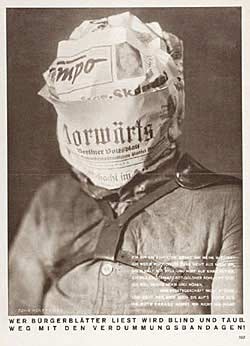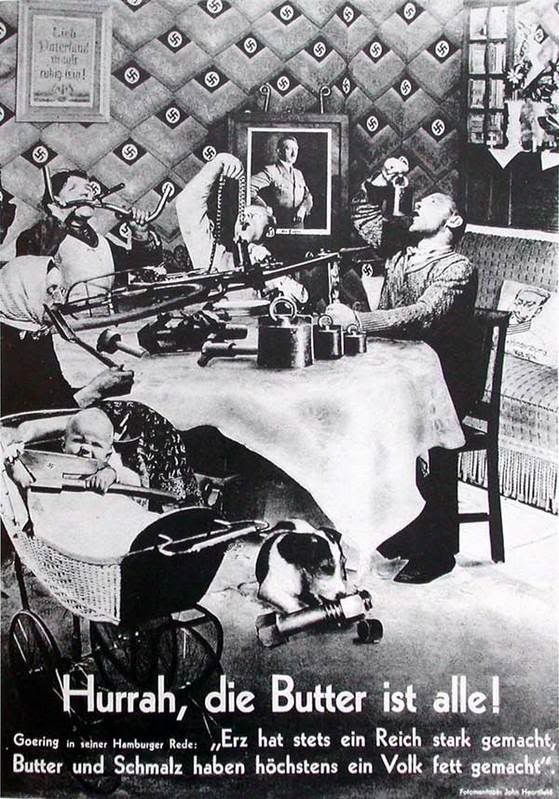anti Nazi photomontage
How the photomontage art of John Heartfield, a contemporary and friend of Brecht, warned the world of the rise of Nazism.
In the 1930s the Nazis were gaining ground in Europe. Many chose to ignore or had a Laissez faire attitude to the national socialist policy of expansionism, known as Lebensraum or the threat of war that Germany now posed to the world. John Heartfield ( above, doing Hitler's hair), A German citizen born Helmut Herzfeld, was one who chose to criticize the regime through art. He produced a remarkable series of photomontages (decades before Photoshop ) The audacity of which can still astonish today.
Blood and Iron
Bismarck had stated that the German people would be reformed through a combination of blood and iron. Heartfield's 1939 photomontage shows exactly how this was to be interpreted in reality. Heartfield had always been a reactionary when it came to German Nationalism. Born 1891 as Helmut Herzfeld he saw the true horrors of the first world war first hand. Although propaganda was rife and rabid on both sides he made the extraordinary move of anglicising his name in 1916, in the middle of the war, to protest against such nationalism.
Hitler prepares to kill the French cockerel
Although some of his work may seem a little primitive in them days of Photoshop, the meaning of Heartfields 1939 work is as sharp as the knife that the dictator is holding. The caption jokes ironically around Hitler's vegetarianism, The French Foreign Minister is seen to be unperturbed at the sharpening of knifes. After all Hitler did not eat meat. Of course by this time Heartfield had to remove himself from Germany (in fact at the beginning of the Nazi Regime) as his sort of political satire would no doubt have earned him a visit in the night and a trip to a concentration camp. He left Germany in 1933, the year Hitler came to power and relocated to nearby Czechoslovakia. Perhaps a little too close for comfort.
Kaiser Adolf
The real motive for Hitler's stranglehold on political power in the thirties was something that was utterly transparent to Heartfield, Here he gives Hitler the emperor's old clothes and upturned moustache to reveal that power had simply changed hands and nothing had changed in democratic terms. As left wings socialist. Heartfield was diametrically opposed to the extreme right wing nationalism (Nazism) that swept Germany.(Although it borrowed policies from both left and right wing). It was after founding a satirical magazine, Die Pleite, that he met Brecht. Later he would work for the weekly A/Z (published in exile, of course, this sort of thing would never have been allowed inside the Fatherland). It was A/Z that he produced most of his photomontage work.
The butter is gone
As the caption on the card says, this is bitterly satirical and based on the words of Goring in 1935. Hermann Goring. One of the potentates of Nazi Germany, said during a food shortage that Iron has always made a nation strong, butter and lard have only made the people fat. If one of the politicians were to say that today there would probably be a riot but satire like this was one of the few ways to injure the regime. possibly Heartfields most famous work. this family attempts to eat the various weapons fo war that have been built instead of the butter that should have been on their table. The swastika wallpaper in the background is a particularly deft touch and shows how the regime permeated all aspects of even domestic life.
The German oak tree
The oak tree is watered by the environmentally aware Hitler. However, what it produces is shells and iron helmets marked with swastikas. As potent an image about how the ideals of a nation will become perverted from the top politically, the oak tree is Germany- watered instead from the bottom. This was produced in 1939 by which time Heartfield had felt it necessary to retreat from his adopted host nation of Czechoslovakia. Soon after, he made it to England and lived in Hampstead, London, for the duration of the war.
Fathers and Sons, 1924 gelatin silver print of photomontage. Akademie der Künste, Berlin, Kunstsammlung
The Middle Ages and the Third Reich
With reference to the medieval torture instrument, the wheel, Heartfeild skilfully adapts the swastika (itself an image accosted and misused by the Nazis) to the picture what was happening to the German people under the "guidance "of Adolf Hitler and his cronies. some might say that this image of suffering is somewhat generous to the German people. portraying them as the victims of Nazism but once Hitler had secured absolute power for himself and with no way of democratically or governmentally relieving him of his position ( as was the case with Mussolini in Italy) then victims is exactly what they were.












One of the the greatest artist of the 20th century - Overlooked - But today he can still teach us what people are not paying attention to.
ReplyDelete